Optical Anapole Modes in Gallium Phosphide Nanodisk with Forked Slits for Electric Field Enhancement
Abstract
:1. Introduction
2. Theory
3. Results and Discussion
4. Conclusions
Supplementary Materials
Author Contributions
Funding
Data Availability Statement
Conflicts of Interest
References
- Shibuta, M.; Eguchi, T.; Nakajima, A. Imaging and Characterizing Long-Range Surface Plasmon Polaritons Propagating in a Submillimeter Scale by Two-Color Two-Photon Photoelectron Emission Microscopy. Plasmonics 2013, 8, 1411–1415. [Google Scholar] [CrossRef]
- Novotny, L.; Hulst, N.V. Antennas for light. Nat. Photonics 2011, 5, 83–90. [Google Scholar] [CrossRef]
- Li, W.; Zhang, J.; Yan, Z.; Peng, Z. Highly enhanced fluorescence of fluorophores inside a metallic nanocavity. Chem. Commun. 2011, 47, 5834–5836. [Google Scholar] [CrossRef]
- Ming, T.; Chen, H.; Jiang, R.; Li, Q.; Wang, J. Plasmon-Controlled Fluorescence: Beyond the Intensity Enhancement. J. Phys. Chem. Lett. 2012, 3, 191–202. [Google Scholar] [CrossRef]
- Darvill, D.; Centeno, A.; Xie, F. Plasmonic fluorescence enhancement by metal nanostructures: Shaping the future of bionanotechnology. Phys. Chem. Chem. Phys. 2013, 15, 15709–15726. [Google Scholar] [CrossRef]
- Kim, S.M.; Zhang, W.; Cunningham, B.T. Coupling diskrete metal nanoparticles to photonic crystal surface resonant modes and application to Raman spectroscopy. Opt. Express 2010, 18, 4300–4309. [Google Scholar] [CrossRef]
- Litorja, M.; Haynes, C.L.; Haes, A.J.; Jensen, T.R.; Duyne, R.P.V. Surface-Enhanced Raman Scattering Detected Temperature Programmed Desorption: Optical Properties, Nanostructure, and Stability of Silver Film over SiO2 Nanosphere Surfaces. J. Phys. Chem. B 2015, 105, 6907–6915. [Google Scholar] [CrossRef]
- Alaee, R.; Albooyeh, M.; Yazdi, M.; Komjani, N.; Simovski, C.; Lederer, F.; Rockstuhl, C. Magnetoelectric coupling in nonidentical plasmonic nanoparticles: Theory and applications. Phys. Rev. B 2015, 91, 115119. [Google Scholar] [CrossRef] [Green Version]
- Agio, M.; Alù, A. Optical Antennas; Cambridge University: Rochester, NY, USA, 2013. [Google Scholar]
- Shibanuma, T.; Albella, P.; Maier, S.A. Unidirectional light scattering with high efficiency at optical frequencies based on low-loss dielectric nanoantennas. Nanoscale 2016, 8, 14184. [Google Scholar] [CrossRef] [Green Version]
- Giannini, V.; Fernández-Domínguez, A.I.; Heck, S.C.; Maier, S.A. Plasmonic nanoantennas: Fundamentals and their use in controlling the radiative properties of nanoemitters. Chem. Rev. 2011, 111, 3888–3912. [Google Scholar] [CrossRef]
- Neubrech, F.; Huck, C.; Weber, K.; Pucci, A.; Giessen, H. Surface-Enhanced Infrared Spectroscopy Using Resonant Nanoantennas. Chem. Rev. 2017, 117, 5110–5145. [Google Scholar] [CrossRef]
- Wu, C.; Khanikaev, A.B.; Adato, R.; Arju, N.; Yanik, A.A.; Altug, H.; Shvets, G. Fano-resonant asymmetric metamaterials for ultrasensitive spectroscopy and identification of molecular monolayers. Nat. Mater. 2011, 11, 69–75. [Google Scholar] [CrossRef] [PubMed]
- Brown, L.V.; Yang, X.; Zhao, K.; Zheng, B.Y.; Nordlander, P.; Halas, N.J. Fan-shaped gold nanoantennas above reflective substrates for surface-enhanced infrared absorption (SEIRA). Nano Lett. 2015, 15, 1272–1280. [Google Scholar] [CrossRef]
- Zijlstra, P.; Paulo, P.M.R.; Orrit, M. Optical detection of single non-absorbing molecules using the surface plasmon resonance of a gold nanorod. Nat. Nanotechnol. 2012, 7, 379–382. [Google Scholar] [CrossRef] [Green Version]
- Pelton, M. Modified spontaneous emission in nanophotonic structures. Nat. Photonics 2015, 9, 427–435. [Google Scholar] [CrossRef]
- Oulton, R.F.; Sorger, V.J.; Zentgraf, T.; Ma, R.M.; Gladden, C.; Dai, L.; Bartal, G.; Zhang, X. Plasmon lasers at deep subwavelength scale. Nature 2009, 461, 629–632. [Google Scholar] [CrossRef] [PubMed] [Green Version]
- Lim, D.K.; Jeon, K.S.; Kim, H.M.; Nam, J.M.; Suh, Y.D. Nanogap-engineerable Raman-active nanodumbbells for single-molecule detection. Nat. Mater. 2010, 9, 60–67. [Google Scholar] [CrossRef]
- Sabri, L.; Huang, Q.; Liu, J.; Cunningham, B. Design of anapole mode electromagnetic field enhancement structures for biosensing applications. Opt. Express 2019, 27, 7196–7212. [Google Scholar] [CrossRef] [PubMed]
- Cui, X.; Lai, Y.; Ai, R.; Ai, R.; Wang, H.; Shao, L.; Chen, H.; Zhang, W.; Wang, J. Anapole States and Toroidal Resonances Realized in Simple Gold Nanoplate-on-Mirror Structures. Adv. Opt. Mater. 2020, 8, 2001173. [Google Scholar] [CrossRef]
- Yao, J.; Li, B.; Cai, G.; Liu, Q. Doubly mirror-induced electric and magnetic anapole modes in metal-dielectric-metal nanoresonators. Opt. Lett. 2021, 46, 576–579. [Google Scholar] [CrossRef]
- Li, Y.; Huang, Z.; Sui, Z.; Chen, H.; Zhang, X.; Huang, W.; Guan, H.; Qiu, W.; Dong, J.; Zhu, W.; et al. Optical anapole mode in nanostructured lithium niobate for enhancing second harmonic generation. Nanophotonics 2020, 9, 3575–3585. [Google Scholar] [CrossRef]
- Zhang, L.; Agarwal Anuradha, M.; Kimerling Lionel, C.; Michel, J. Nonlinear group iv photonics based on silicon and germanium: From near-infrared to mid-infrared. Nanophotonics 2014, 3, 247–268. [Google Scholar] [CrossRef]
- Miroshnichenko, A.E.; Evlyukhin, A.B.; Yu, Y.F.; Bakker, R.M.; Chipouline, A.; Kuznetsov, A.I.; Lukyanchuk, B.; Chichkov, B.N.; Kivshar, Y.S. Nonradiating anapole modes in dielectric nanoparticles. Nat. Commun. 2015, 6, 8069. [Google Scholar] [CrossRef]
- Zenin, V.A.; Evlyukhin, A.B.; Novikov, S.M.; Yang, Y.; Malureanu, R.; Lavrieneko, A.V.; Chichkov, B.N.; Bozhevolnyi, S.I. Direct amplitude-phase near-field observation of higher-order anapole states. Nano Lett. 2017, 17, 7152–7159. [Google Scholar] [CrossRef] [PubMed] [Green Version]
- Radescu, E.E.; Vaman, G. Exact calculation of the angular momentum loss, recoil force, and radiation intensity for an arbitrary source in terms of electric, magnetic, and toroid multipoles. Phys. Rev. E. 2002, 65, 046609. [Google Scholar] [CrossRef]
- Zhang, X.; Wang, S.; Lin, Z.; Sun, H.B.; Chan, C.T. Optical force on toroidal nanostructures: Toroidal dipole versus renormalized electric dipole. Phys. Rev. A 2015, 92, 043804. [Google Scholar] [CrossRef] [Green Version]
- Evlyukhin, A.B.; Fischer, T.; Reinhardt, C.; Chichkov, B.N. Optical theorem and multipole scattering of light by arbitrarily shaped nanoparticles. Phys. Rev. B 2016, 94, 205434. [Google Scholar] [CrossRef]
- Aspnes, D.E.; Studna, A.A. Dielectric functions and optical parameters of Si, Ge, GaP, GaAs, GaSb, InP, InAs, and InSb from 1.5 to 6.0 eV. Phys. Rev. B 1983, 27, 985–1009. [Google Scholar] [CrossRef]
- Erhard, M.; Junghans, A.R.; Nair, C.; Schwengner, R.; Beyer, R.; Klug, J.; Kosev, K.; Wagner, A.; Grosse, E. Experimental study of the electric dipole strength in the even Mo nuclei and its deformation dependence. Phys. Rev. C 2010, 81, 034319. [Google Scholar] [CrossRef] [Green Version]
- Yang, Y.; Zenin, V.A.; Bozhevolnyi, S.I. Anapole-assisted strong field enhancement in individual all-dielectric nanostructures. ACS Photon. 2018, 5, 1960–1966. [Google Scholar] [CrossRef] [Green Version]
- Kurk, S.; Kivshar, Y. Functional meta-optics and nanophotonics govern by Mie resonances. ACS Photon. 2017, 4, 2638–2649. [Google Scholar] [CrossRef] [Green Version]
- Caldarola, M.; Albella, P.; Cortes, E.; Rahmani, M.; Roschuk, T.; Grinblat, G.; Oulton, R.F.; Bragas, A.V.; Maier, S.A. Non-plasmonic nanoantennas for surface enhanced spectroscopies with ultra-low heat conversion. Nat. Commun. 2015, 6, 7915. [Google Scholar] [CrossRef] [PubMed] [Green Version]
- Dodson, S.; Haggui, M.; Bachelot, R.; Plain, J.; Li, S.; Xiong, Q. Optimizing electromagnetic hotspots in plasmonic bowtie nanoantennae. J. Phys. Chem. Lett. 2013, 4, 496–501. [Google Scholar] [CrossRef] [PubMed]
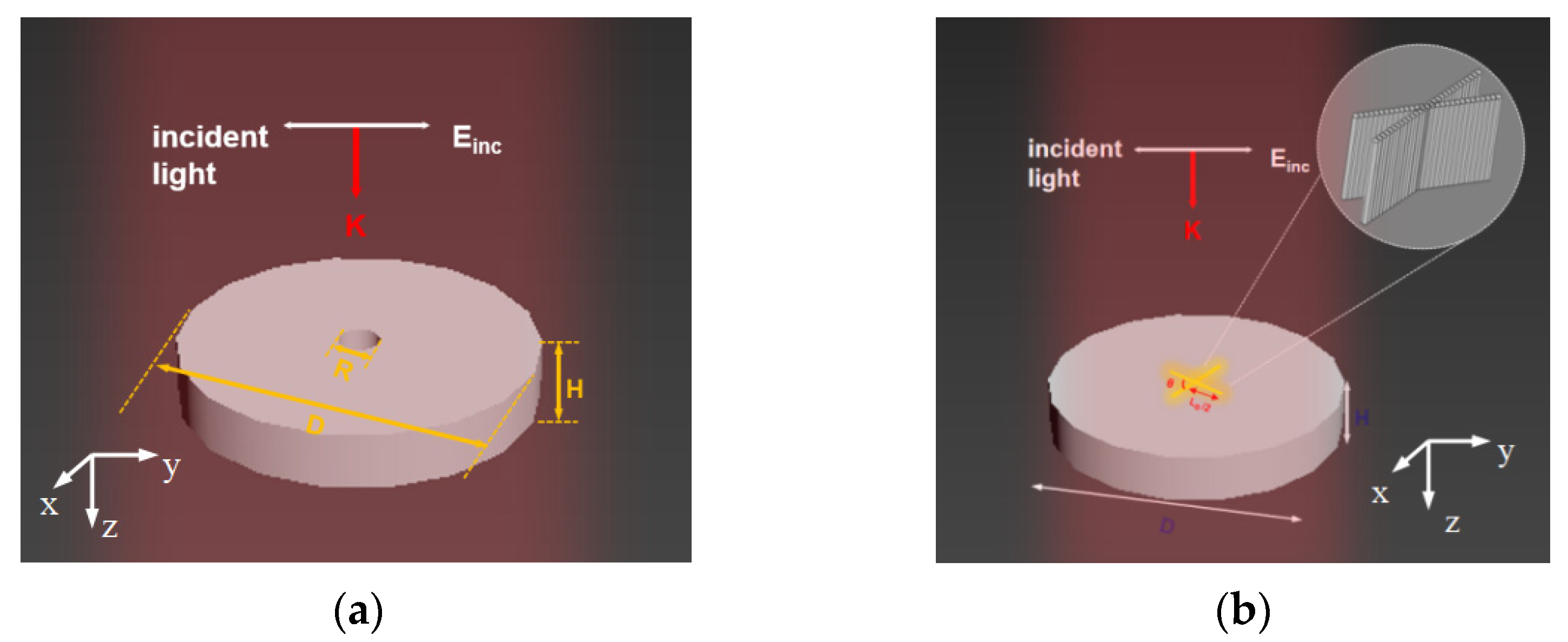
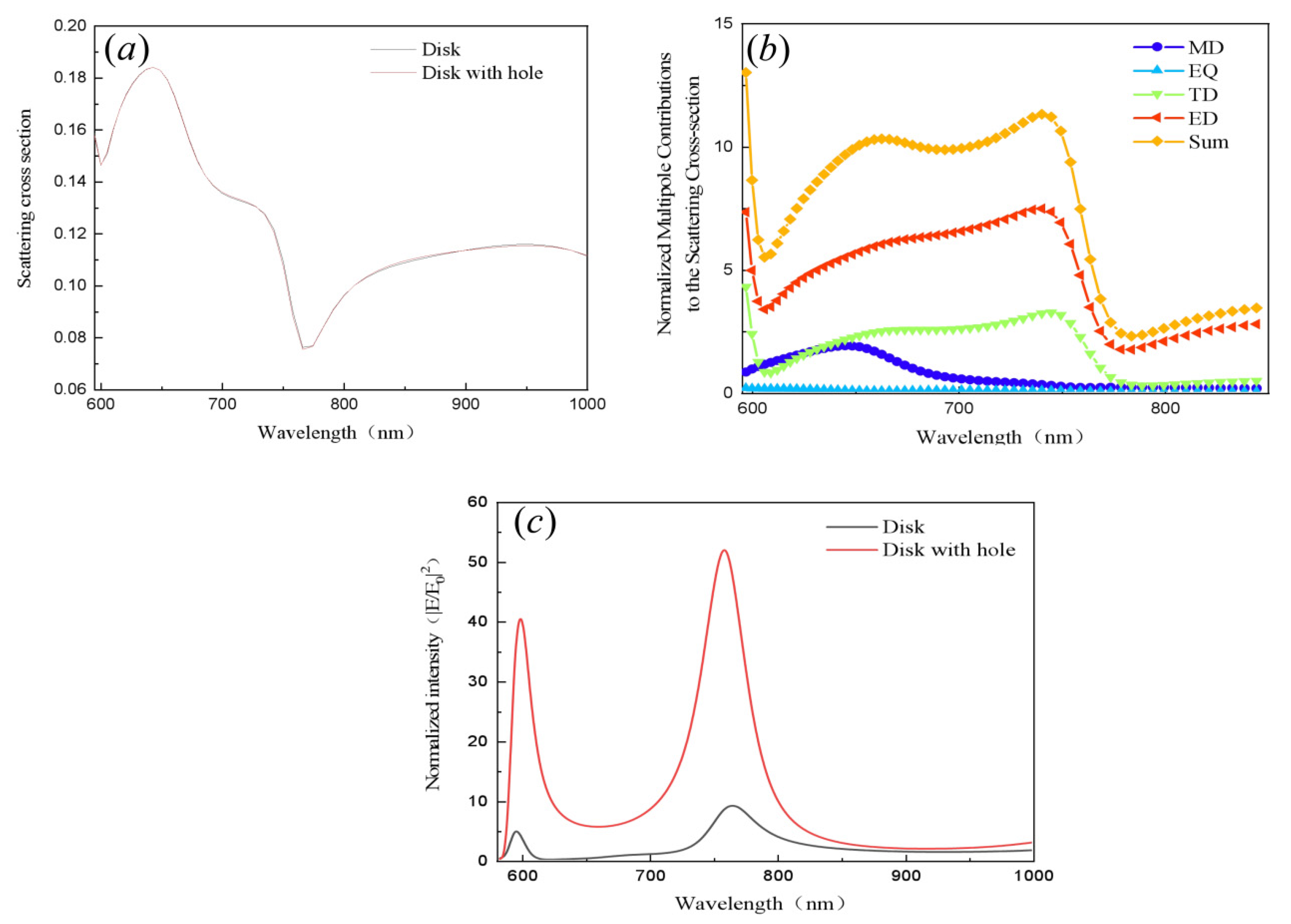
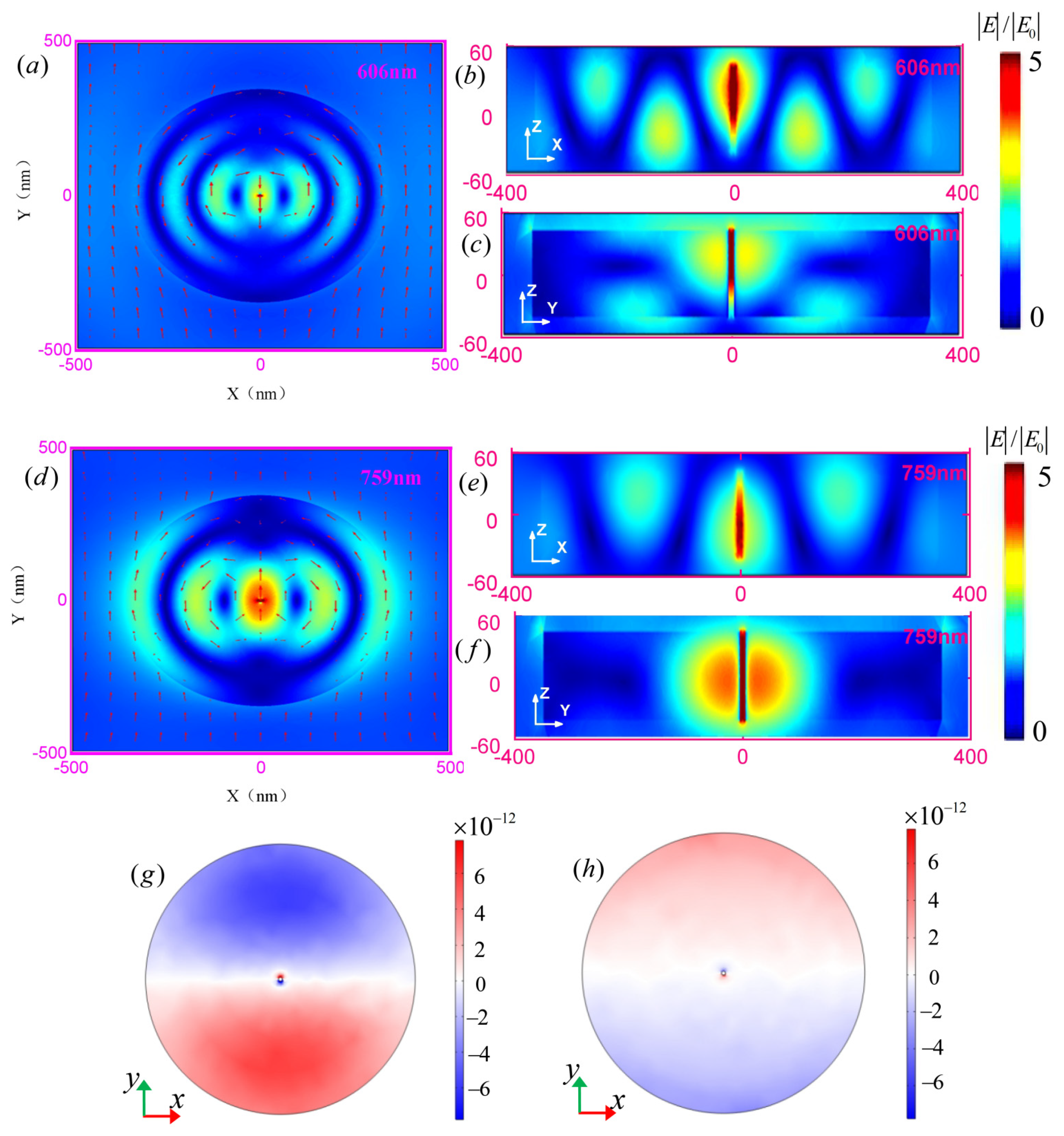
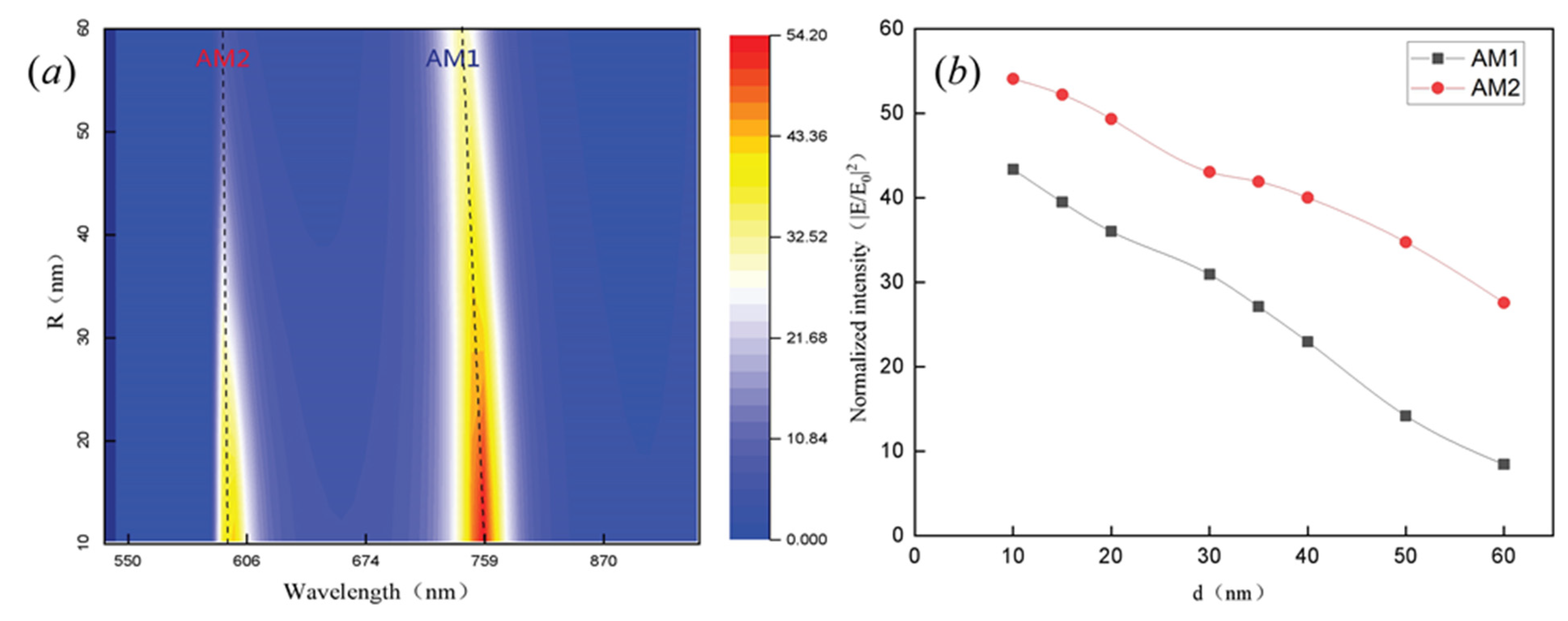


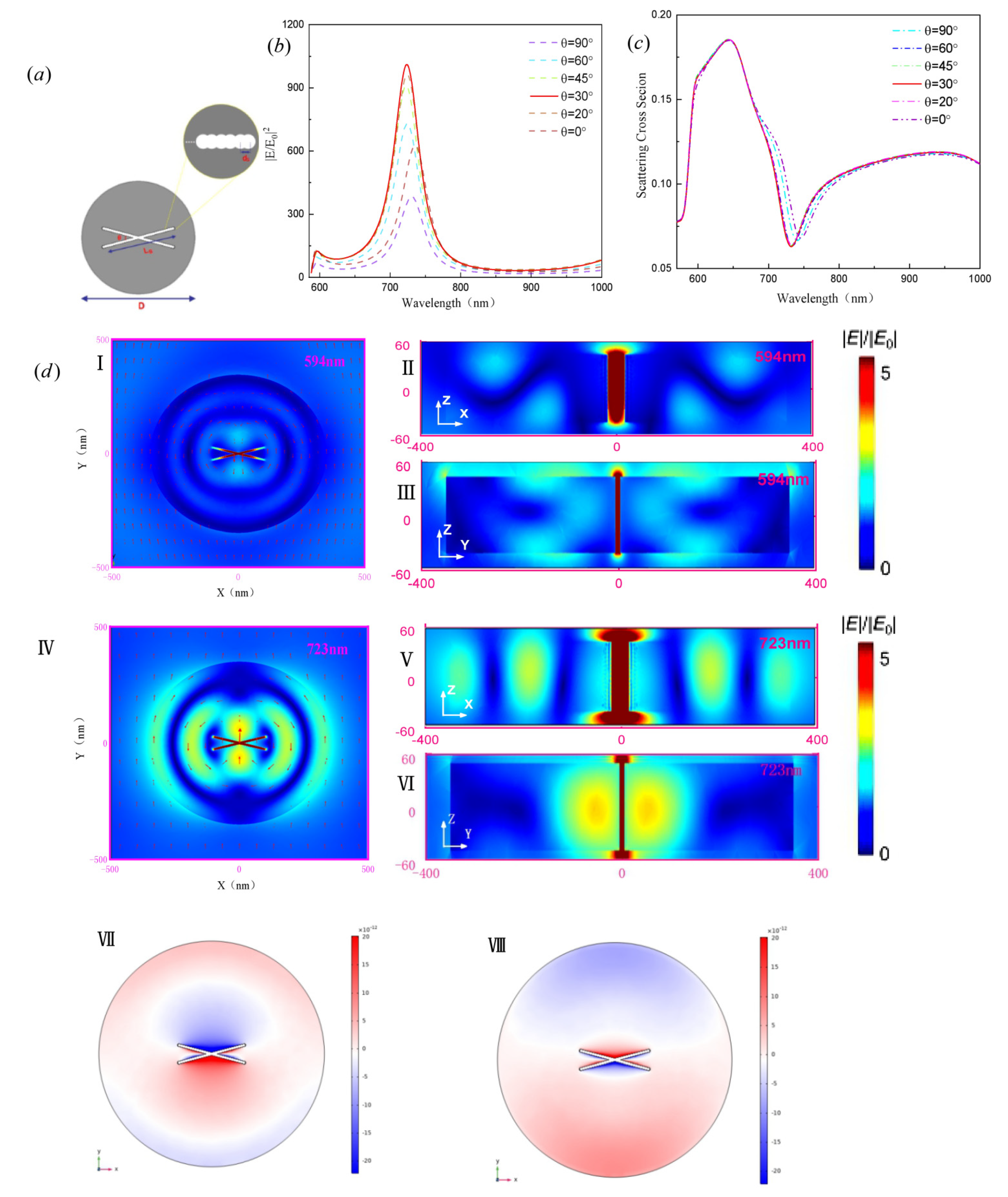
Publisher’s Note: MDPI stays neutral with regard to jurisdictional claims in published maps and institutional affiliations. |
© 2021 by the authors. Licensee MDPI, Basel, Switzerland. This article is an open access article distributed under the terms and conditions of the Creative Commons Attribution (CC BY) license (https://creativecommons.org/licenses/by/4.0/).
Share and Cite
Lv, J.; Zhang, H.; Liu, C.; Yi, Z.; Wang, F.; Mu, H.; Li, X.; Sun, T.; Chu, P.K. Optical Anapole Modes in Gallium Phosphide Nanodisk with Forked Slits for Electric Field Enhancement. Nanomaterials 2021, 11, 1490. https://doi.org/10.3390/nano11061490
Lv J, Zhang H, Liu C, Yi Z, Wang F, Mu H, Li X, Sun T, Chu PK. Optical Anapole Modes in Gallium Phosphide Nanodisk with Forked Slits for Electric Field Enhancement. Nanomaterials. 2021; 11(6):1490. https://doi.org/10.3390/nano11061490
Chicago/Turabian StyleLv, Jingwei, He Zhang, Chao Liu, Zao Yi, Famei Wang, Haiwei Mu, Xianli Li, Tao Sun, and Paul K. Chu. 2021. "Optical Anapole Modes in Gallium Phosphide Nanodisk with Forked Slits for Electric Field Enhancement" Nanomaterials 11, no. 6: 1490. https://doi.org/10.3390/nano11061490





